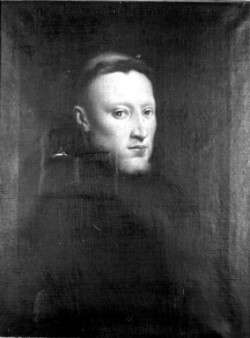Onofrio Panvinio

The erudite Augustinian Onofrio Panvinio or Onuphrius Panvinius (23 February 1529 — 7 April 1568) was an Italian historian and antiquary, who was librarian to Cardinal Alessandro Farnese.
Life and work
Panvinio was born in Verona. At the age of eleven, he entered the order of Augustinian Hermits and in 1539 he went to Rome and became fascinated by the city, whose topography and inscriptions, ancient and medieval history, writers and great papal families he would document through a spectacularly productive brief lifetime.
After graduating in Rome as bachelor of arts in 1553 and teaching the novices of his order in Rome and Florence, in 1557 he obtained the degree of doctor of theology. He visited the libraries of Italy, pursuing historical research and went to Germany in 1559. Refusing the position of bishop, he accepted the more grateful office of corrector and reviser of the books of the Vatican Library in 1556. He died in Palermo while accompanying his friend and protector Cardinal Farnese to the Synod of Monreale, 1568.
He was recognized as one of the greatest church historians and archaeologists of his time. The scholarly printer Paulus Manutius called him antiquitatis helluo ("a glutton for antiquity"), and Julius Caesar Scaliger styled him pater omnis historiae ("father of all history").
His great archaeological map of ancient Rome was produced in 1565.[1] About the same time he began to collaborate with the French engraver Étienne Dupérac, who continued to provide illustrations for posthumous printings of Panvinio's works. Not all of his numerous historical, theological, archaeological, and liturgical works were published, even posthumously; some are preserved in manuscript in the Vatican Library.
His portrait by Tintoretto is in the Galleria Colonna.[2]
Publications

- De fasti et triumphi Romanorum a Romulo usque ad Carolum V, (Giacomo Strada, Venice, 1557), "Fasti and triumphs of the Romans from Romulus to Charles V";
- A revised edition of Carolus Sigonius's Fasti consulares (Venice, 1558);
- De comitiis imperatoriis (Basel, 1558);
- De republica Romana (Venice, 1558); "On the Roman Republic";
- Epitome Romanorum pontificum (Venice, 1557); "Brief history of the Roman pontiffs";
- A revised edition of Bartolomeo Platina's De vitis pontificum (Venice); "On the lives of the popes";
- XXVII Pontif. Max. elogia et imagines" (Rome, 1568); "Elogies and images of twenty-seven pontiffs";
- "De sibyllis et carminibus sibyllinis" (Venice, 1567) ("Of sibyls and Sibylline oracles");
- Chronicon ecclesiasticum a C. Julii Caesaris tempore usque ad imp. Maximilianum II (Cologne, 1568); "Ecclesiastical chronicle from the time of Julius Caesar to that of Emperor Maximilian";
- De episcopatibus, titulis, et diaconiis cardinalium (Venice, 1567);"of the bishoprics, tituli and diaconates of the cardinals";
- De ritu sepeliendi mortuos apud veteres Christianos (Cologne, 1568); "Of burial rites for the dead among the early Christians";[3]
- De praecipuis urbis Romae santioribusque basilicis (Rome, 1570; Cologne, 1584);
- De primatu Petri et apostolicae selis potestate (Verona 1589): "Of the primacy of Peter and the power of the apostolic see";
- Libri X de varia Romanorum pontificum creatione (Venice, 1591);
- De bibliotheca pontificia vaticana (Tarragona, 1587); "On the pontifical Vatican Library";
- Augustiniani ordinis chronicon (Rome, 1550); "Chronicle of the Augustinian Order";
- De ludis circensibus (Venice, 1600); "On the circus games". A posthumous publication with etchings by Dupérac that date to the 1560s.
- Epitome antiquitatum romanarum (Rome, 1558);
- De antique Romanorum religione; "On the ancient religion of the Romans";
Karl Gersbach, OSA, has published numerous articles on aspects of Panvinio's career. Philip Jacks set his career in the context of early antiquarian investigations in The Antiquarian and the Myth of Antiquity: The Origins of Rome in Renaissance Thought. (Cambridge University Press) 1993. The only modern biography is Jean-Louis Ferrary's bibliographic study, Onofrio Panvinio et les antiquités romaines (Rome) 1996.
Notes
- ↑ "The map, the description, the monuments of ancient Rome, have been elucidated by the diligence of the antiquarian and the student," wrote Edward Gibbon in the last chapter of The Decline and Fall of the Roman Empire (1787), but in a footnote (ch. 13, note 75 on-line text) remarked Bernard de Montfaucon's dismissal of Panvinius, as a scholar qui omnes obscuravit, "who obscured everything".
- ↑ "Jacopo Tintoretto – Onofrio Panvinio – Sala della Apoteosi". Galleria Colonna. Retrieved 22 August 2013.
- ↑ Panvinio's discussion of the Christian catacombs was text-based; the physical exploration of them was the life work of Antonio Bosio.
External links
 Herbermann, Charles, ed. (1913). "Onofrio Panvinio". Catholic Encyclopedia. New York: Robert Appleton Company.
Herbermann, Charles, ed. (1913). "Onofrio Panvinio". Catholic Encyclopedia. New York: Robert Appleton Company.- De ludis circensibus is located at the Special Collections/Digital Library in Falvey Memorial Library at Villanova University.
- Onofrio Panvinio, in Dizionario biografico degli Italiani (Stefan Bauer), vol. 81, 2014, pp. 36-39.